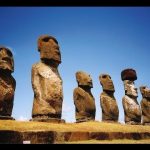Jet/Volcanic Glass…used for tools on Easter Island Moai Statues!
“Going Back in Time”…Another supercool piece from ‘Spaceship Earth’…Obsidian was also used on Rapa Nui (Easter Island) for edged tools such as Mataia and the pupils of the eyes of their Moai (statues).
Glass Mountain, a large obsidian flow at Medicine Lake Volcano
Obsidian can be found in locations which have experienced rhyolitic eruptions. It can be found in Argentina, Armenia, Azerbaijan, Canada, Chile, Georgia, Greece, El Salvador, Guatemala, Iceland, Italy, Japan, Kenya, Mexico, New Zealand, Peru, Scotland, Turkey and the United States. Obsidian flows which may be hiked on are found within the calderas of Newberry Volcano and Medicine Lake Volcano in the Cascade Range of western North America, and at Inyo Craters east of the Sierra Nevada in California. Yellowstone National Park has a mountainside containing obsidian located between Mammoth Hot Springs and the Norris Geyser Basin, and deposits can be found in many other western U.S. states including Arizona, Colorado, New Mexico, Texas, Utah, Washington,[14] Oregon[15] and Idaho. Obsidian can also be found in the eastern U.S. states of Virginia, as well as Pennsylvania and North Carolina.
There are only four major deposit areas in the central Mediterranean: Lipari, Pantelleria, Palmarola and Monte Arci.[16]
Ancient sources in the Aegean were Melos and Giali.[17]
Acigöl town and the Göllü Dağ volcano were the most important sources in central Anatolia, one of the more important source areas in prehistoric Near East
Historical use
Obsidian arrowhead
The first archaeological evidence known of usage were made from within Kariandusi and other sites of the Acheulian age (beginning 1.5 million years previously) dated 700,000 BC, although the number of objects found at these sites were very low relative to the Neolithic.[21][22][23][24][25] Use of obsidian in pottery of the Neolithic in the area around Lipari was found to be significantly less at a distance representing two weeks journeying.[17] Anatolian sources of obsidian are known to have been the material used in the Levant and modern-day Iraqi Kurdistan from a time beginning sometime about 12,500 BC.[26] The first attested civilized use is from excavations at Tell Brak dated the late fifth millennia.[27] Obsidian was valued in Stone Age cultures because, like flint, it could be fractured to produce sharp blades or arrowheads. Like all glass and some other types of naturally occurring rocks, obsidian breaks with a characteristic conchoidal fracture. It was also polished to create early mirrors. Modern archaeologists have developed a relative dating system, obsidian hydration dating, to calculate the age of obsidian artifacts.
Middle East[edit]
Obsidian tools from Tilkitepe, Turkey, 5th millennium BC. Museum of Anatolian Civilizations
In the Ubaid in the 5th millennium BC, blades were manufactured from obsidian mined in what is now Turkey.[28] Ancient Egyptians used obsidian imported from the eastern Mediterranean and southern Red Sea regions. Obsidian was also used in ritual circumcisions because of its deftness and sharpness.[29] In the eastern Mediterranean area the material was used to make tools, mirrors and decorative objects.[30]
Obsidian has also been found in Gilat, a site in the western Negev in Israel. Eight obsidian artifacts dating to the Chalcolithic Age found at this site were traced to obsidian sources in Anatolia. Neutron activation analysis (NAA) on the obsidian found at this site helped to reveal trade routes and exchange networks previously unknown.[31]
Americas[edit]
See also: Obsidian use in Mesoamerica
Leave A Reply
You must be logged in to post a comment.









 Paranormal
Paranormal

